July 27th, 2014 §
I stuck a spring of borage into one of my homegrown bouquets and have fallen even more in love with this most-beautiful herb. In the indirect light of my foyer the zillion tiny hairs along each stem appear to glow. It is a magical-looking plant, and one I connect with deeply.
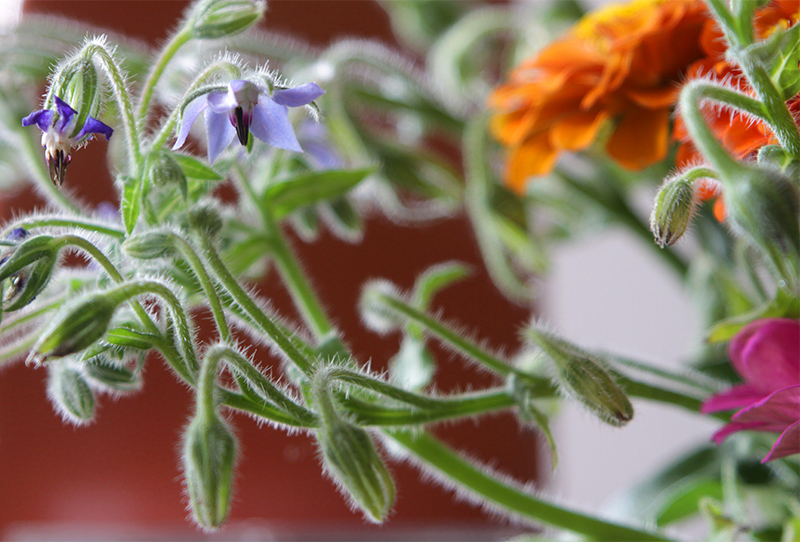
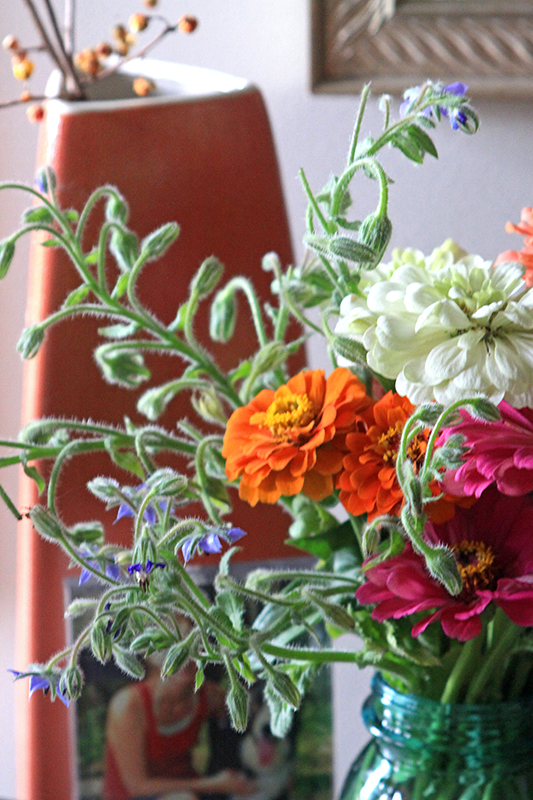
I grew this borage from seed, direct-sown this spring. It definitely needs a lot of sun—the seed I sowed in the shadow of some other plants failed to thrive, but the plants in the sun grew huge and vigorous and are covered with blooms. I didn’t expect it to do well as a cut flower—many herbs wilt in the house—but it’s proven to be a tremendous asset to my flower arrangements. And it’s a timely discovery, as one of my gardening goals this year was to expand my palette of cut flowers.
July 15th, 2014 §
You’d be forgiven for thinking the name of this blog should be Bugs, Birds and Buck Mountain. Posting has been heavy on the natural history lately, I suppose because I want to keep a record of the creatures that share this land with me. That, and baby birds are just cool.
But fear not—there is still some farming happening at Bonafide Farm, and as it’s been months since the last vegetable garden update that’s what we’ll do today.

I will be the first to admit that I am not in love with this garden this year, for several reasons. First, when I planted it in April I was pretty sure I would be moving away from the farm at the end of summer and didn’t think too seriously about where I put things. Second, the overwintered greens took up a vast amount of valuable real estate, and though I enjoyed them as we emerged from winter we had a long, cool spring and I didn’t get to pull them out to use their space for something else until just now, when it’s really too hot and dry to get much going. Finally, my veg garden is just too small, and plants are packed too tightly for all of them to get the sunlight they need to thrive. I hate working around them when they are so thick, always worrying about brushing against a wheel bug or hidden wasp nest.
I haven’t yet expanded the garden because that requires another goat rope of getting huge posts, pounding them in, digging in chicken wire around the perimeter, etc., not to mention beginning to improve the soil by shoveling tractor buckets of compost, all of which is doable but after having spent four painful months and thousands of dollars on a rotator cuff injury this winter I am leery of straining my still-fragile shoulder.
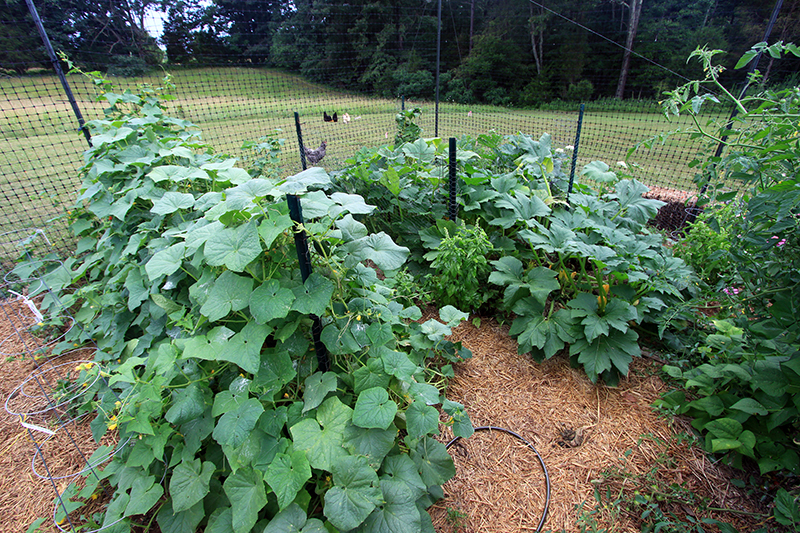
So, the garden is what it is. It’s not the most organized or pretty but it’s putting out vegetables and flowers and that’s all I suppose it really has to do. There have been some surprises this season. The most notable is that my squash, which usually falls victim to squash bugs around the time it’s ready to harvest, is chugging along just fine. It’s in the photo above, to the right of the massive cucumber installation. I don’t know if the polar vortex is behind this lower squash bug population this year, or if it has to do with moving the squash to a new location in the garden. I do know that for the first time ever I am using an “organic” pyrethrin dust, which I applied when the plants were young and every so often now. I don’t think that’s entirely the reason, though, as it’s a contact insecticide, not really a repellant, and I just haven’t seen much evidence of squash bugs or their eggs. Of course I may be totally jinxing myself by even writing this. The irony is I planted the squash in amongst other things, anticipating that it would be dead by now and the other plants could take over. But that’s not how it’s turning out, and I suppose I shouldn’t be complaining about something living instead of dying!

Again I am overrun with cucumbers. I think it’s because when you buy little two-leafed cuke seedlings they come about eight to a pot so it’s easy to overplant. Nobody needs this many cucumbers. But again, like with the squash, I expected these plants to have fallen to the cucumber beetles by now and they haven’t. The chickens are getting a lot of cucumbers.
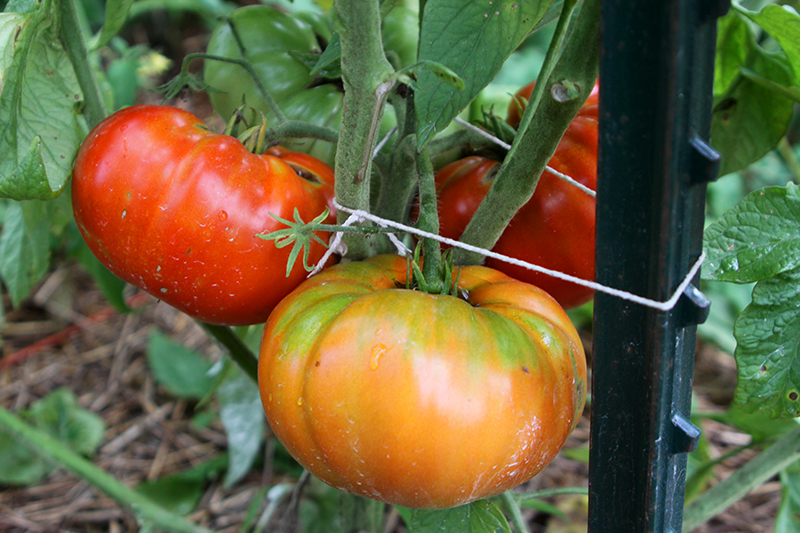
The tomatoes are all now mostly taller than I, and I am trying a new technique with them in that I did not pinch off any suckers. All my life I was of the “pinch the suckers” school of tomato growing, but this year I thought I’d let them go and see what happened. What happened was massive plants that I tried to tie up last night, which required full-body hugging the plants as I collected each vine near the post. I guess tomatoes need love too. Even planted on generous 36″ centers, the plants are growing together making harvest hard. But I did pick my first big tomatoes last night, with “Early Girl” for the win, and others are right behind. That’s “Brandywine” above, nice and big. The plants are gorgeous and healthy, with just the tiniest bit of manageable fungus-related yellowing near the base.
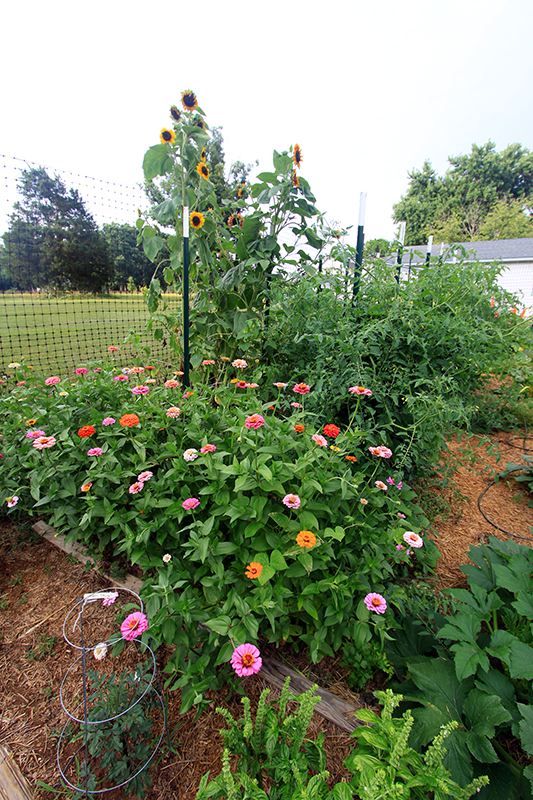
I have a few rows of cutting flowers—zinnias and cosmos, and some volunteer gladiolus that I tried to dig out this spring but obviously I didn’t manage to get all the bulbs. There are lots of surprises that germinated from years’ past and I just let go, such as random green beans, unidentified greens, the sunflowers above, and a very mysterious white squash rambling through the cosmos. Like I said, kind of a mess.
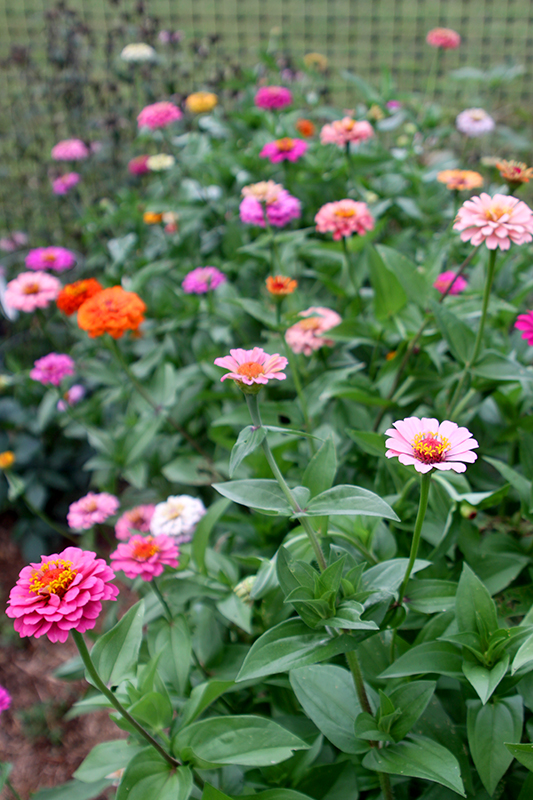
But here we are, mid-July, and this is what I have to work with. The summer is going so fast that I know it will be only a few more weeks before everything goes round the bend and starts its late-summer decline.
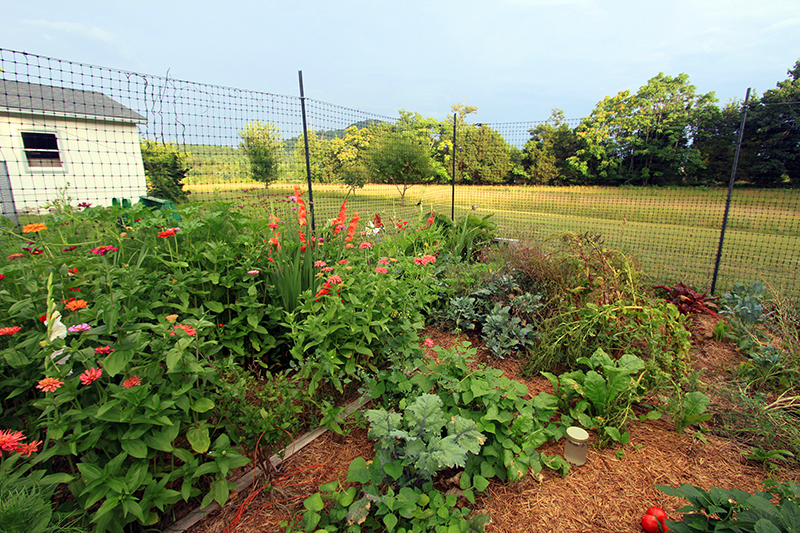
And the nice thing about gardening is that each year you get a do-over. Maybe this fall I will get the garden expanded and then have fresh land to cultivate next year. I really want to put in a ton of perennial fruits and vegetables that need space to mature, such as berry bushes, asparagus, rhubarb, and strawberries, so that’s a good incentive to get out the dreaded t-post driver.
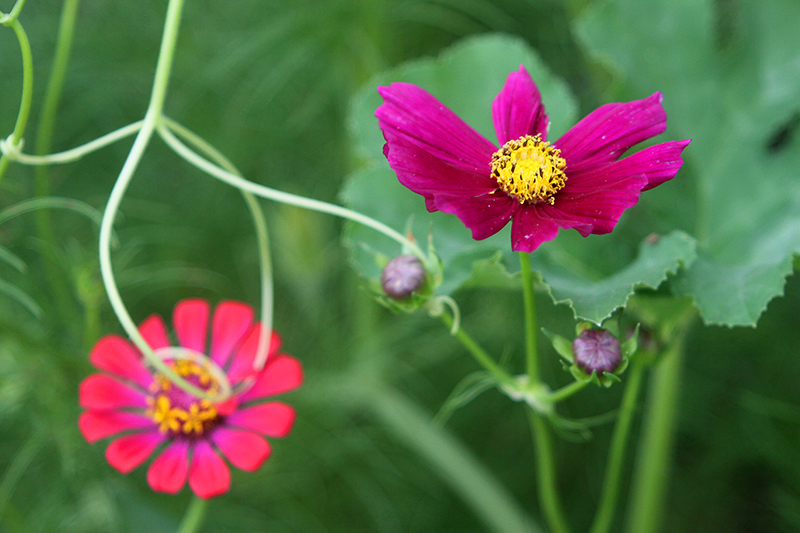
June 5th, 2014 §
It’s finally time for one of my favorite gardening days of the year: redoing the front porch containers. Each spring, after the winter’s pansies poop out from rising temperatures, I get the instant gratification of putting together tiny minigardens to be appreciated up close each time I enter the house.
This year my mom and I discovered a fantastic greenhouse, Milmont, over the mountain in Stuarts Draft. Not only did they have varieties of plants that have been on my wish list for ages, and that I’d resigned myself to having to mail-order, they also had a thriving colony of purple martins living right near their greenhouses. Awesome, rare birds + spectacular, rare plants = pretty much my idea of heaven.
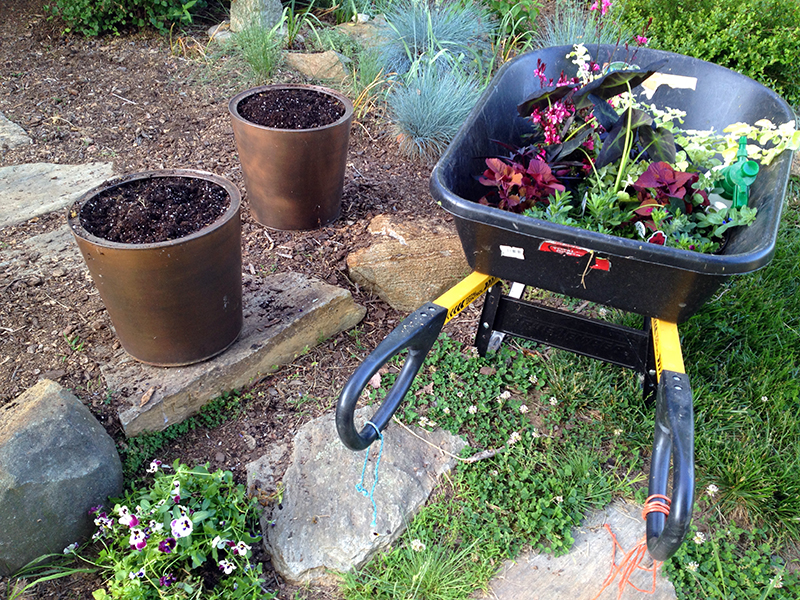
I came home with all the material for this summer’s container gardens and broke down the old arrangements, composting the spent pansies and then refreshing the pots with new soil and granular fertilizer. Then I got down to designing.
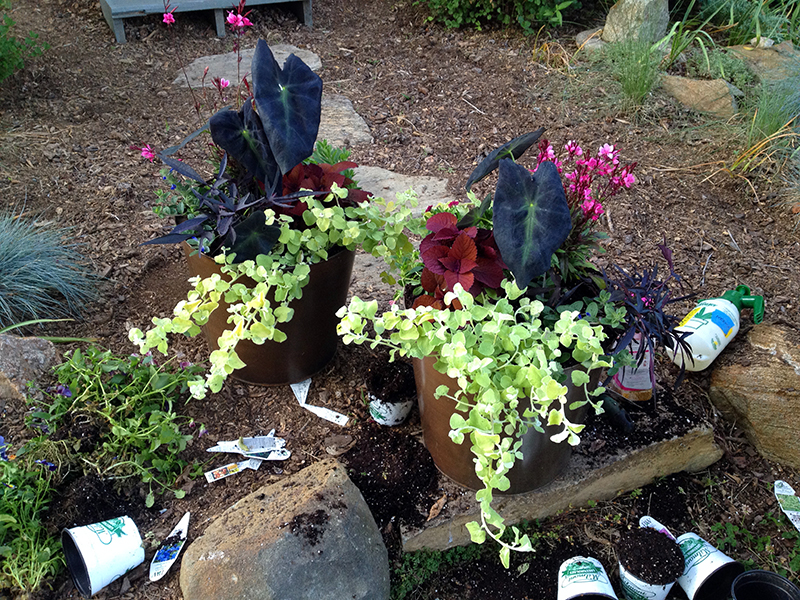
This year I wanted high-contrast color, dramatic leaf form, and to play around with some black foliage. To that end, the centerpiece of each container is a black Colocasia ‘Ilustris,’ and that tone is picked up again in black sweet potato vine, ‘Illusion Midnight Lace,’ which will spill over the edges. I always like to add rusty red-pink colors, because they are my favorite and tie into the color of my front door. For that I used Coleus ‘Colorblaze Keystone Kopper.’ I was really drawn to the icy, otherworldly green of Helichrysum petiolare ‘Lemon Licorice,’ to contrast with the black and brighten everything up. For color, I popped in a dwarf Gaura ‘Karalee Petite Pink,’ as well as Calibrachoa ‘Minifamous Double Magenta,’ which has bright pink flowers that look like tiny roses. And for a ringer, I added a shot of pure, bright blue with Evolvulus ‘Blue My Mind.’
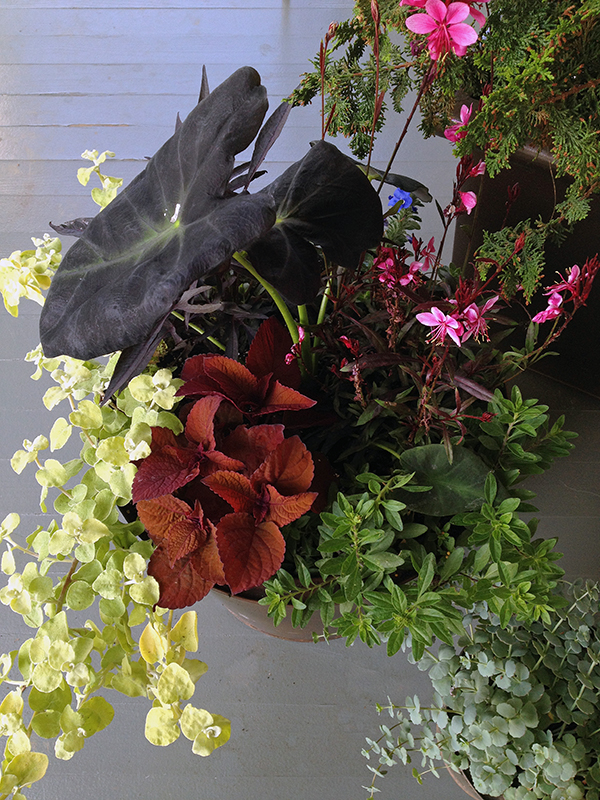
The key to good containers, in addition to following the “thriller, spiller, filler” formula, is to stuff in way more plants than you think could fit. Yes, containers planted this fully require more attention with watering and feeding, but you get an instant, lush look. I already know that some of these plant will, if they’re happy, grow too large for these containers, so throughout the summer I will need to keep them trimmed and shaped up to continue looking nice. Not a hard task, and the added bonus is I can root the trimmings and make more plants!
The front porch, all dressed up for summer: the large evergreens below are some form of Chamaecyparis, which I’ve had for more than two years. They are very slow-growing and do okay in pots as long as they don’t dry out, but eventually they will need to be planted out in the yard. I refreshed their soil last year. The plant in the smallest pot is Sedum ‘October Daphne,’ which I cut back each winter for fresh regrowth.
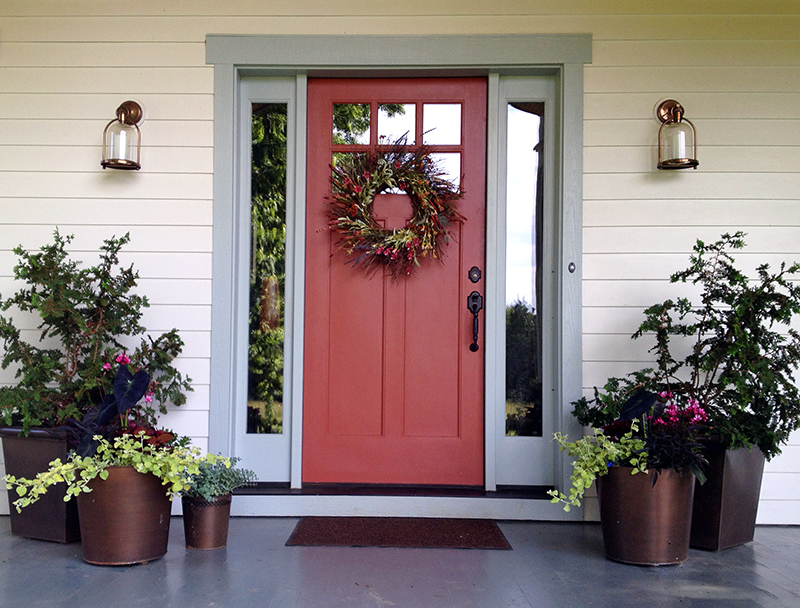
And a purple martin parting shot:
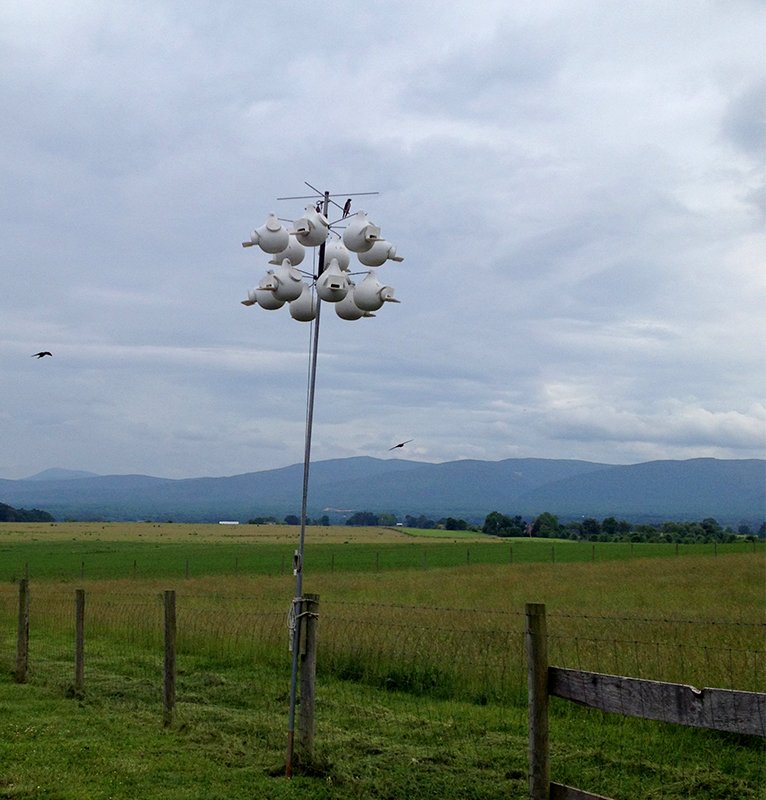
May 30th, 2014 §
For weeks I’ve been watching a little house wren sit on a tidy nest in a front-garden shrub. I’d found the nest with my spade raised to prise the bush from the ground for relocation. Four blue, brown-speckled eggs popped into view, tucked just inside.
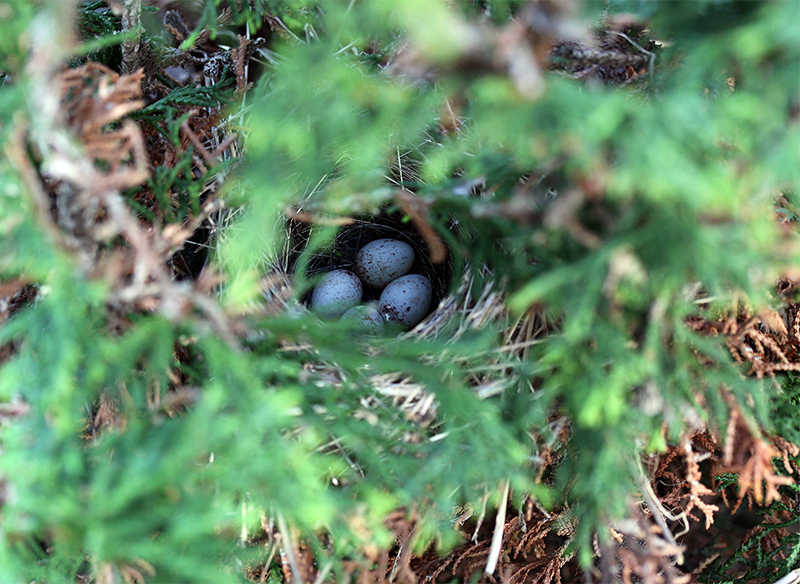
Obviously, landscaping was postponed, and each day I checked on the nest, always expecting the eggs to be gone. They were precariously sited in a bush not two feet off the ground, easy pickings for a snake or raccoon or possum. I considered surrounding the bush with some sort of barrier, but knew that the only thing that would keep a snake out was fine netting. I learned my lesson last summer when a large black snake got stuck and died in the netting I installed to protect the garden from the chickens. So I chose not to intervene with the nest.
Without any “help,” the eggs persisted, and two days ago the mother wren didn’t fly off the nest when I approached. She flattened her body in place, with only her brave eyes moving, and I knew her eggs had hatched.
Yesterday I went out to feed the chickens and saw Tucker bent over something in the grass. I knew that posture. Immediately I checked the nest, and it was empty.
I went back to where Tuck had been standing and searched the dewy clover. I found two little bodies, perfectly bloodless and still warm. I picked them both up, and they curled together in the palm of my hand as they must have in the nest. I almost felt their hearts beating against my skin, but knew it was only wishful thinking. Nearby the mother bird swooped and chattered, scolded and cried.
I buried the babies in a scrape of dirt, and went on with my chores, silent and avoiding eye contact with my dog. Of course I was sad but I had no right to be angry. I knew Tucker was only doing one of his jobs, hunting. A wild baby bird in an ill-positioned nest is to him no different than a rabbit flushed from the wellhouse or mole dug out of the pasture, and all are fair, encouraged game.
As I’d wrapped up the chicken chores I moved some flats of seedlings out of the shed into the rain. I glanced down and saw that my crepe myrtle, still in its gallon nursery pot, had leafed out by several inches from the base.
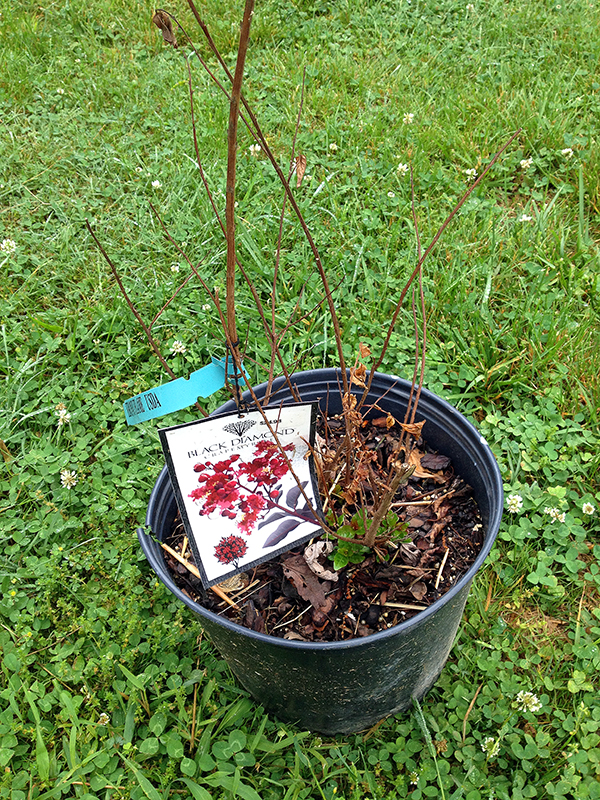
Seems reasonable until I tell you that I’d tortured this plant all last summer, letting it go bone dry and sunburned, as I prevaricated about where in the ground to stick it. And then summer became fall became our incredibly cold and snowy winter, all during which the pot of dead sticks sat unprotected outside of the wellhouse. I was disappointed in myself that I’d killed a perfectly good future tree by not being able to make a simple, timely decision, and just a few days ago I had accepted my crepe myrtle was toast and mentally pitched it on the compost pile.
But in that short interval between intention and action this forsaken plant had quietly, and on its own schedule, conveyed to me its plan to live.
Doing or not doing. Both are choices, and the joke of this choose-your-own-adventure is that we’re all just bumbling along. In a span of five minutes I got a perfect lesson in acting and not acting, and how each movement’s consequences can be both predictable and surprisingly unexpected.
I am going outside now to plant a crepe myrtle.
May 20th, 2014 §
This spring, the garden I’ve been most impressed with is the one I have spent the least amount of time thinking about and fussing over. Isn’t that the way it is with so many things—just set the ball rolling, get out of the way and wait to be unexpectedly amazed?

The strip of garden that runs along the east side of the house was an afterthought in many ways, even though it is the garden closest to the road and should be a showpiece. When the house was built I threw some shrubs in to hold the soil on the bank—a few doublefile viburnums and some dwarf oakleaf hydrangeas, two of my favorite shrubs. Then last year I extended the garden by building the rock wall, and added some gift irises and a few more little plants as I bought them. Because there are no evergreens it looks pretty bare in winter, but this spring the bank erupted in what turned out, this year, to be a quite nice combination of bloom, leaf shape, and color variation. It’s a very old-fashioned feeling garden, with classic plants that one might find around Grandma’s country cottage.
The first to bloom are the the daffodils in late winter, and I am happy to see that their decaying foliage will soon be hid by the new growth coming in on the shrubs, just as it should be. I particularly love the variegated Solomon’s Seal (Polygonatum odoratum var. pluriflorum ‘Variegatum’) at lower right, below, with its white bell-like blooms and sturdy foliage that remains attractive all season.
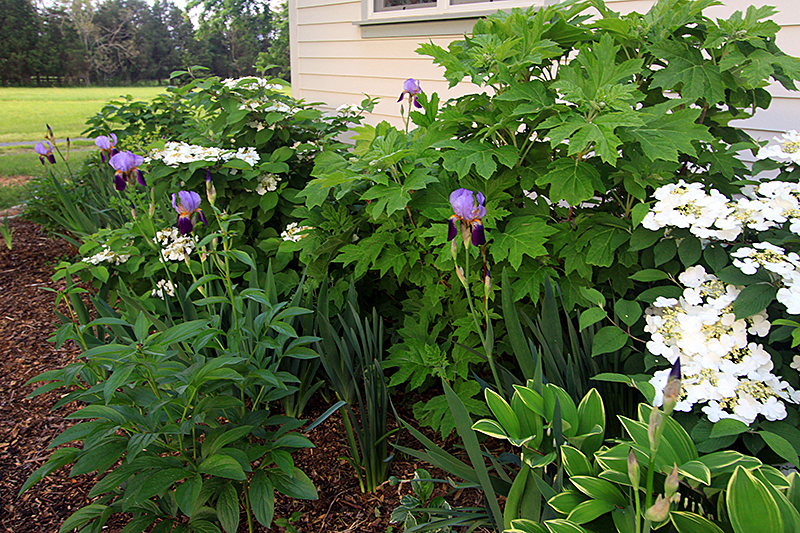
The front corner is anchored by these nice catmints (Nepeta ‘Walker’s Low’), new last year, that continue the lavender bloom color begun by the iris.
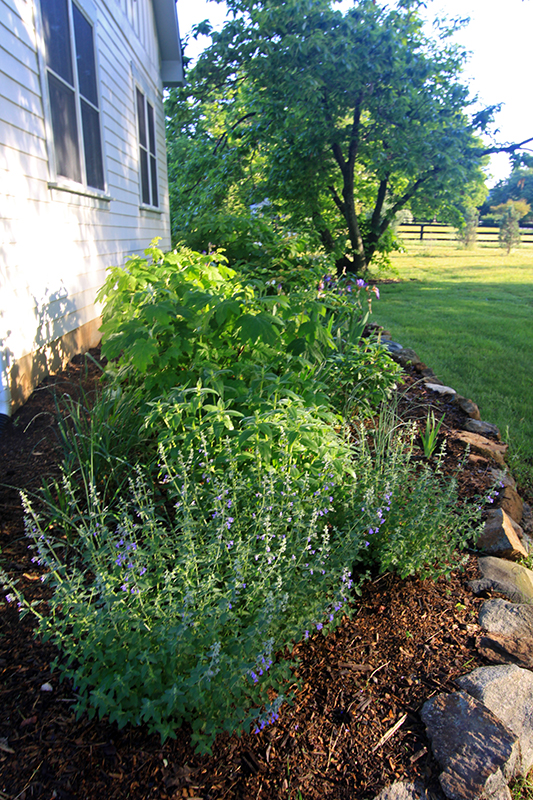
The viburnums have finished their bloom, and the irises are soon to say goodbye. I have a few peonies, planted last spring to test if they liked this location, that are budding now. I will see how they look when they bloom, and if I like the effect I will add more peonies to continue the colorful blooms a few more weeks. That should take me until hydrangea time…but after that I will have to figure out what to add to maintain interest here through the dog days of summer until the hydrangeas change into their red leafed costumes for a fall display.
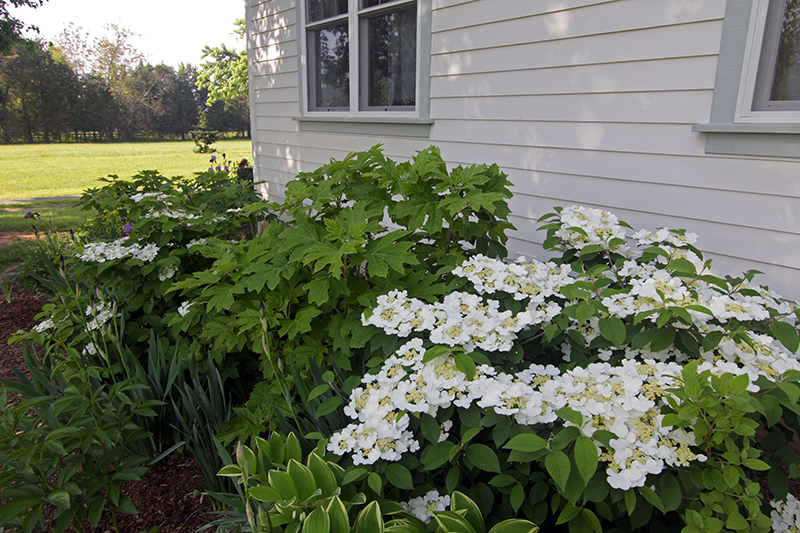
Next fall I will divide the Solomon’s Seal to spread bits of it through the whole garden, and to move it more forward of the shrubs. If I can find something low and pretty all season (maybe some kind of Ajuga, which has purple blooms at the same time as the iris?) to go right along the top of the rock wall, this will really shape up nicely—almost as if I planned it!
And then just when it looks awesome there’s a good chance the shrubs will have grown too large and it will be time to pull them out and start over!
As a way of explaining some of my happiness with this garden’s progress, check out what it looked like just a bit more than a year ago:
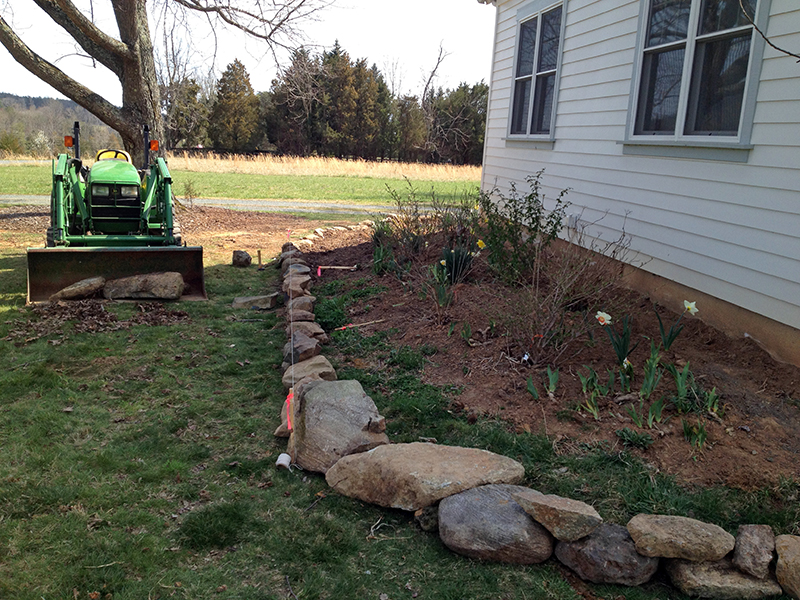
Seeing this photo it’s clear to me that I did the right thing by extending the garden to lessen the slope away from the house, which was making it hard to keep enough water on the shrubs to make them happy, and all the plants responded really well to the back-fill addition of forest-dug compost and a thick blanket of mulch. The border is deep enough (10 feet) that I am able to enjoy the show from inside the house, looking out through the windows, which is an aspect that is so enjoyable but that few consider when creating foundation plantings.
May 8th, 2014 §
The day I buy the vegetables that will be the year’s summer garden is always a happy day. The first smell of crushed tomato leaves jolts awake some deeply-buried, winter-weary brain synapses and floods my entire body with relief and joy. When the tomatoes come out, winter’s really over. We made it through another one.
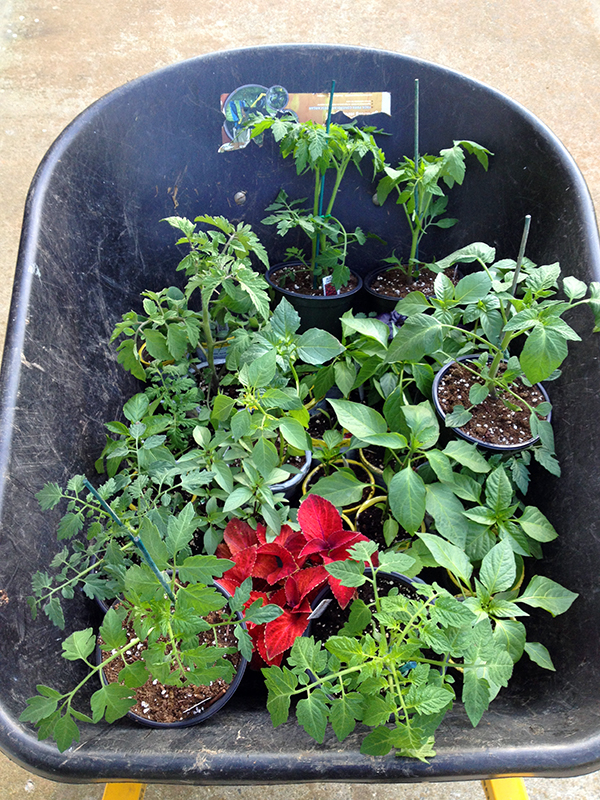
It’s hard to imagine it today when an entire garden’s worth of veg fits in the wheelbarrow, but in a couple of months these small plants will be pumping out enough produce to keep my family and me in good supply, with extra left over for freezing or friends.
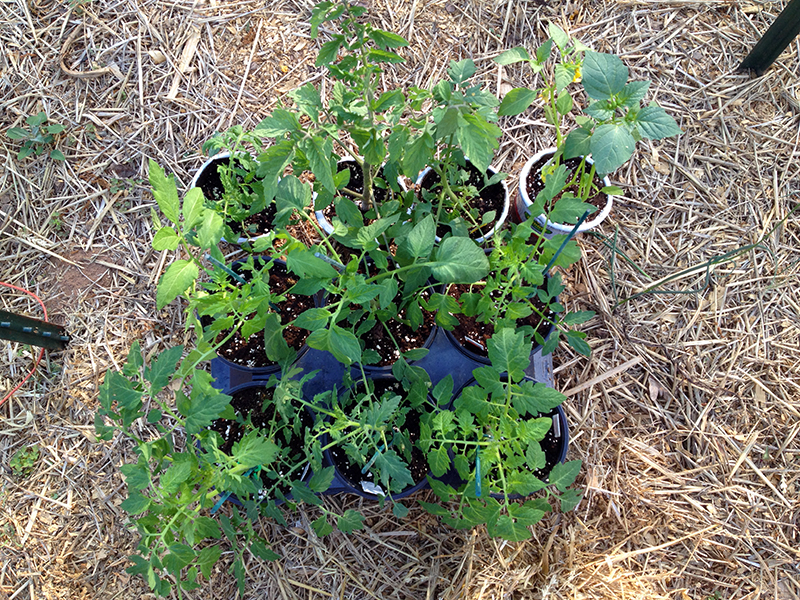
That is, of course, if I am lucky and smart in my battle against innumerable insects, diseases, and weather. Growing pesticide-free food, at least in central Virginia, is a nonstop intellectual challenge, a chess game of anticipation and reaction. It’s never easy, but I suppose that’s why I keep doing it.
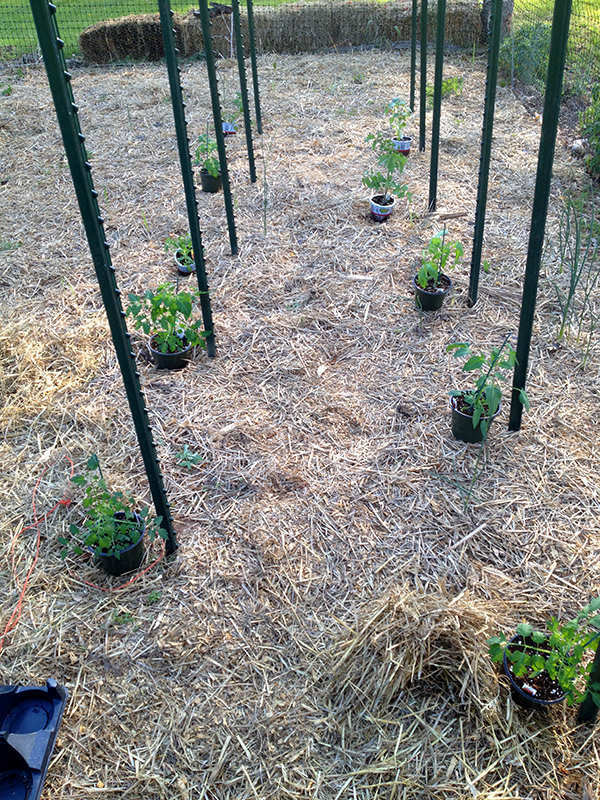
Let the games begin!
March 24th, 2014 §
Last fall I had grand ideas of building a cold frame to overwinter spinach, kale, chard, and salad greens. In late October, right before the first frost, I stuffed 18 strawbales in the bed of the pickup and when I got home used them to build a small fortress around some rows of greens that I’d sowed earlier in the fall.
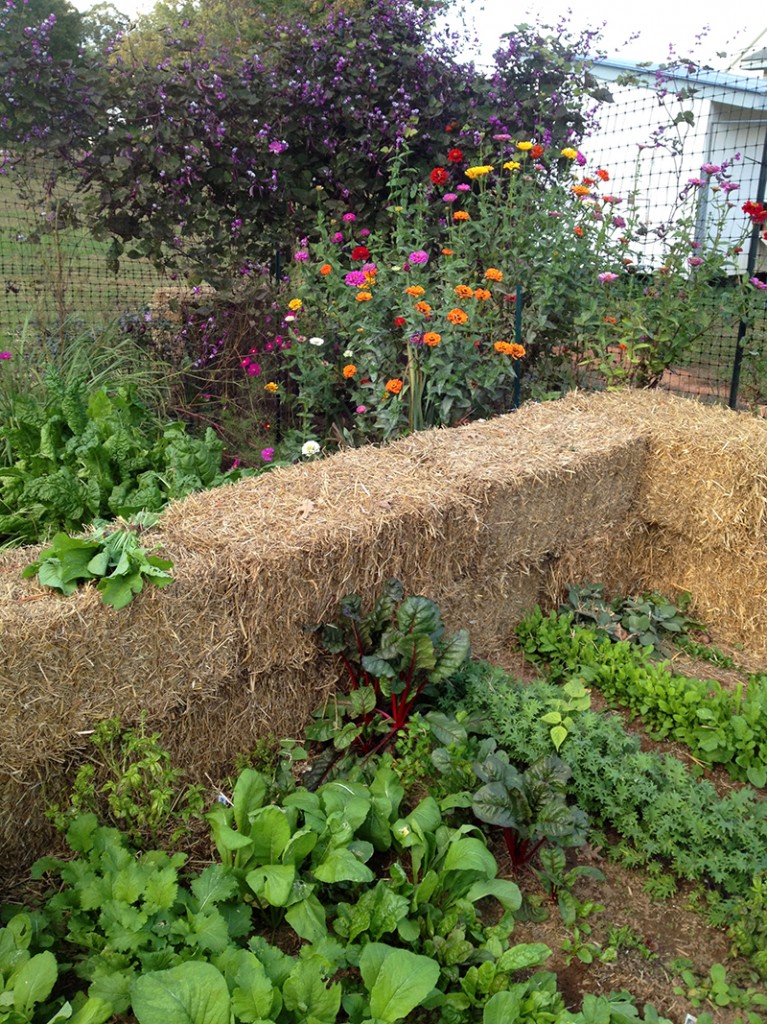 October 22, 2013
October 22, 2013
I made a one-and-a-half-story, south-facing design thinking that the angle would help trap the sun’s heat and shed water off the big sheet of contractor’s plastic that I draped over the top for a lid. I secured the plastic on top of the bales with some scrap lumber, bricks, and cinder blocks. It was admittedly a hot mess to look at, but that’s one reason that I hid the veg garden out of sight from the house and road!
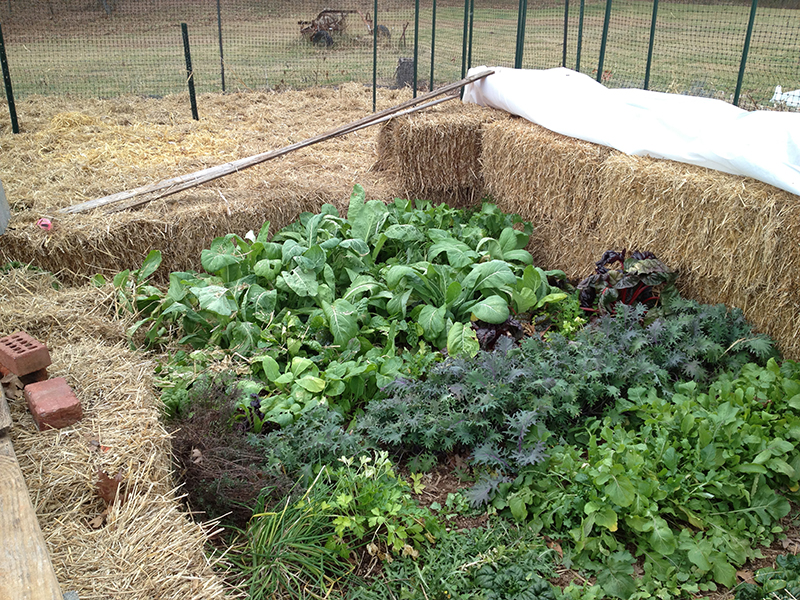 December 5, 2013
December 5, 2013
Things looked good into December, and I kept harvesting greens. But then it started to get really cold and going out to the garden to wrestle with frozen plastic and the icebergs caught in its folds didn’t appeal. So I abandoned the cold frame to the savages of this very long, cold, and snowy winter.
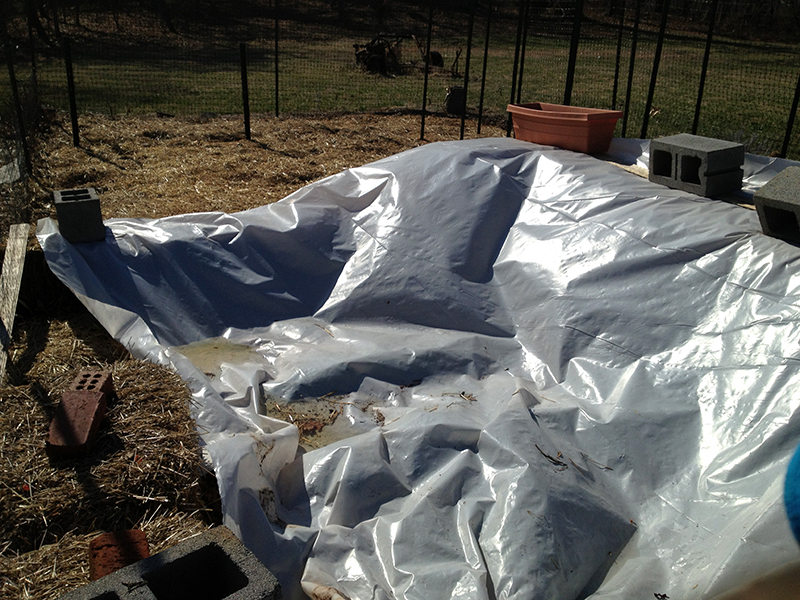
Today I thought I would peek under the plastic, and I was surprised to find quite a few plants happily growing. There were vigorous-looking weeds starting to set seed, though outside the protection of the cold frame none of these weeds are growing yet anywhere on the property—proof that I was successful at creating a little warm microclimate! I was pleased to see chicory, which is called a weed but is actually a very healthy edible spring tonic that you can add to your salad. The Red Russian kale looked pretty good, as did the spinach, and the arugula was flowering. The chard and mustard didn’t make it through as well.
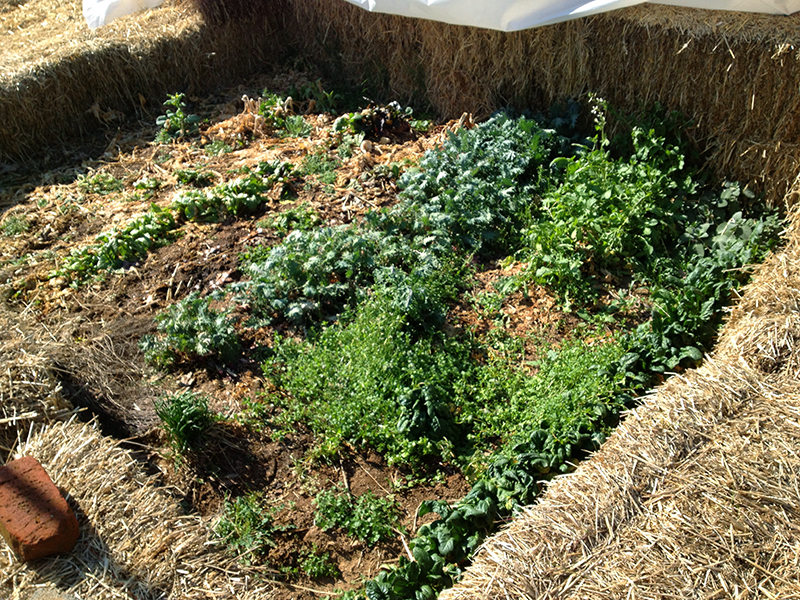 March 24, 2014
March 24, 2014
This is a happy discovery as these little plants, which have existed in suspended animation over the winter, mean a jump on the spring growing season—saving weeks of waiting for spring-sown seed to germinate in cold soil. These plants are undoubtedly strong beneath the surface, and all they will need to get up and growing is some more heat and water. After we get through this week—with more cold temps and even possible snow tomorrow—I will start opening the top of the cold frame for short spells to get the plants used to the temperatures and sun.
When it comes time to plant the whole garden, I will spread the nicely aged straw in these bales around the garden as part of my deep mulching soil-conditioning and weed-suppressing strategy.
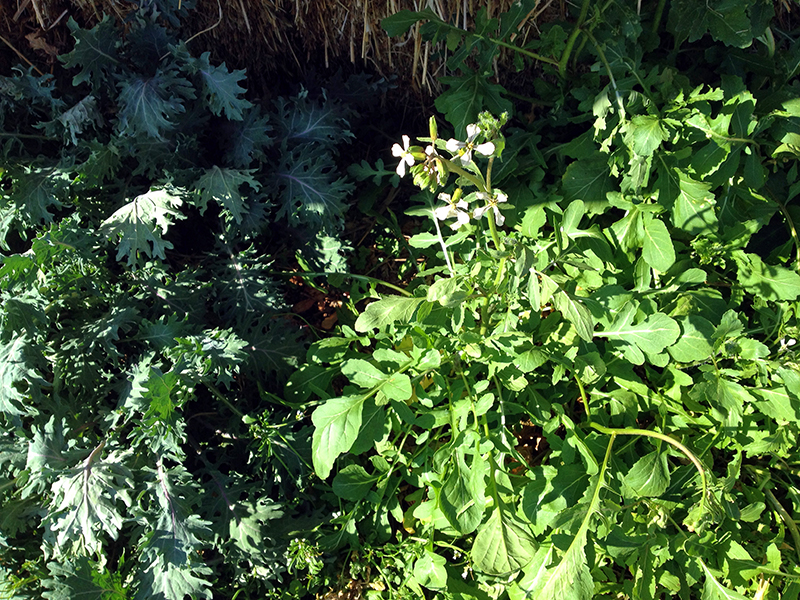
I will still probably sow some more greens from seed, just to experiment, but while I wait I will be enjoying winter-sweetened greens that amazingly hung in there through multiple polar vortices, being flattened under 16″ of snow, and everything else this winter threw at them.
I am pretty happy that what I thought was a failed experiment at getting greens to grow all winter actually isn’t a total failure. I maybe wasn’t eating lush garden-grown salad in the deepest part of winter, but I can right now, and I probably could have weeks ago had I just peeked under the plastic!
January 22nd, 2014 §
Snowplows are rumbling outside my window, the white stuff’s still coming down, and temps are cold enough to warrant a red-light district in the chicken coop. Sounds like a great time to revisit England in July, this time to the Royal Botanic Gardens, Kew—a must-see spot on any gardener’s tour of England.
Kew was founded in 1759 and declared a UNESCO World Heritage Site in 2003. I thought that seemed pretty old until I looked up the world’s oldest botanical garden, which is in Padua, Italy and was created in 1545. The Padua garden is also a World Heritage Site, according the UNESCO, “considering that the Botanical Garden of Padua is the original of all botanical gardens throughout the world, and represents the birth of science, of scientific exchanges, and understanding of the relationship between nature and culture. It has made a profound contribution to the development of many modern scientific disciplines, notably botany, medicine, chemistry, ecology, and pharmacy.” Most people don’t immediately think of all these far-reaching implications of gardening, but there you have it, and it’s all true.
But that’s enough trivia—we came here to see Kew, and Padua will just have to join the very long list of gardens yet to be visited. In addition to being a top London tourist attraction, Kew is also a research institution for plant science and conservation. I can’t speak to any sort of research that’s happening at Kew, and can only appreciate it as a gardener. It’s definitely impressive, and huge, and though I’ve visited it twice on separate trips to England, I am sure there is still more to see. Far be it from me to cover it all in a couple of posts, so I will just focus on the areas most interesting to me.
In addition to giant, Victorian-era glasshouses that house palms and tropicals, there are a few more modern structures:

The structure above, to the left, is the newest glasshouse and one of my favorites. It’s the Davies Apline House, a rock garden full of all sorts of tiny little plants—most of them seeming Mediterranean in origin. I love how these small plants are basically served up on rocky platters, brought close for use to appreciate them in detail and in pleasing contrast to their rocky ledges. Can you believe that four full-time staff and one trainee are dedicated to the care of this glasshouse, which isn’t much larger than what you see in the photo? That is wonderful to me—so many talents and resources dedicated to such tiny plants in a little space.
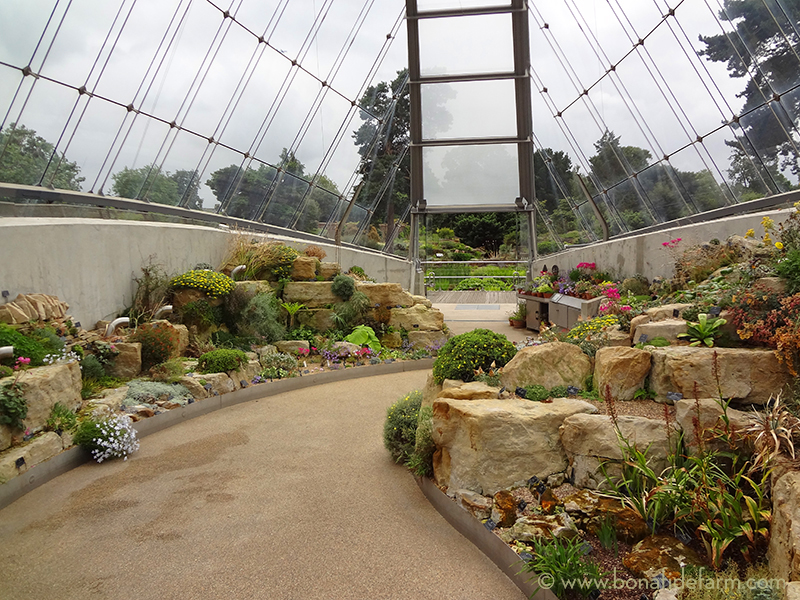
It was in this display that I found a spectacular oregano, Origanum amanum, from Turkey. It’s similar to a hybrid ornamental I grow in my own garden, Origanum “Kent Beauty.” The blue flower in the photo is some sort of bell flower.
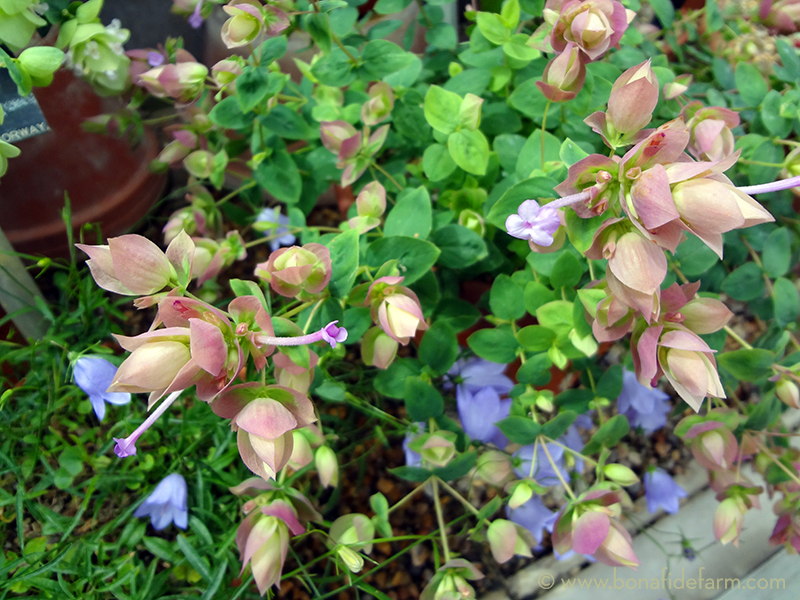
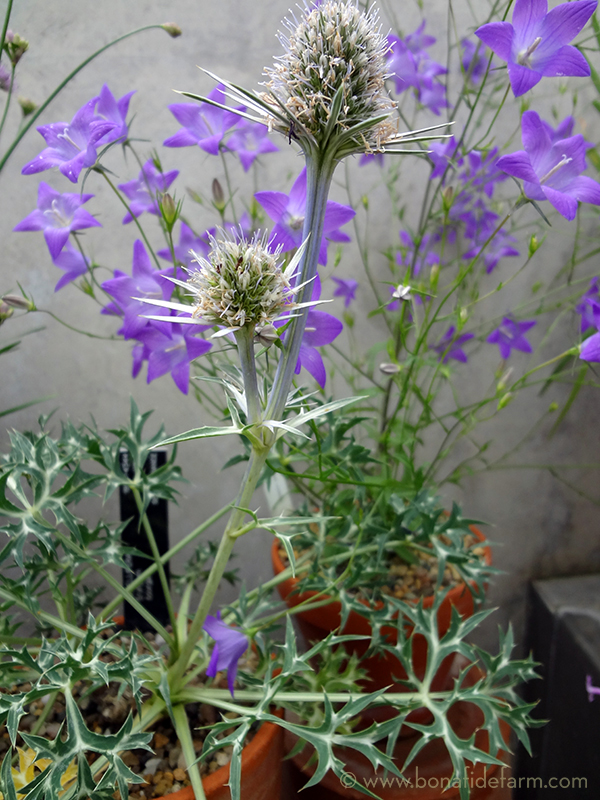
Just outside this glasshouse is an outdoor rock garden, which is one of my favorite areas of Kew. What I like about it, again, is how the rocks form a stage that elevate into the spotlight small and perhaps easily overlooked plants.
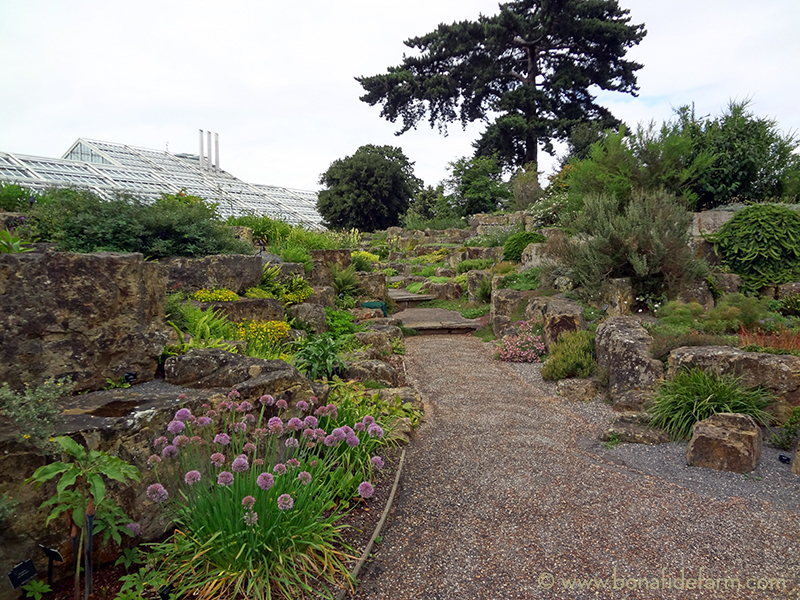
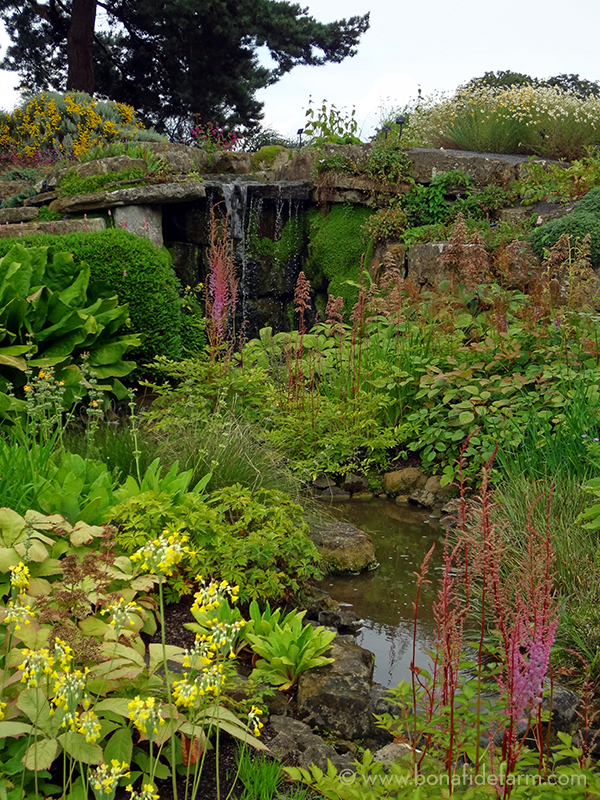
Near this area is a series of great meadows planted with all sorts of grasses. I love the painterly effect of their intermingling, and that they would be relatively low maintenance. This is definitely an idea I’d like to try somewhere on my own property—once I can get past the on-the-surface foolishness of replacing a perfectly good natural meadow with a cultivated one!
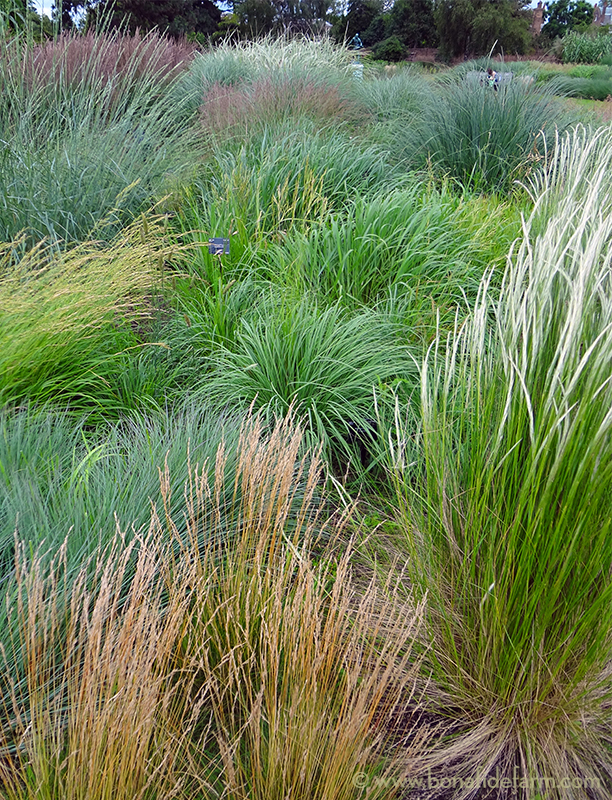
I won’t focus too much on the glasshouses, as I found them to be the least interesting part of Kew. They’re neat in that they’re old, and have lots of peeling-white-paint patina, but the plantings inside them just weren’t as interesting to me as what was going on outside. Perhaps that’s because I approach every garden visit with an eye toward what I can appropriate for Bonafide Farm, and a greenhouse full of tropicals just isn’t in my future. Although, funnily enough, my neighbors opened a winery centered on a giant greenhouse full of tropicals, so it’s certainly possible right in this mountainous little valley in Central Virginia.
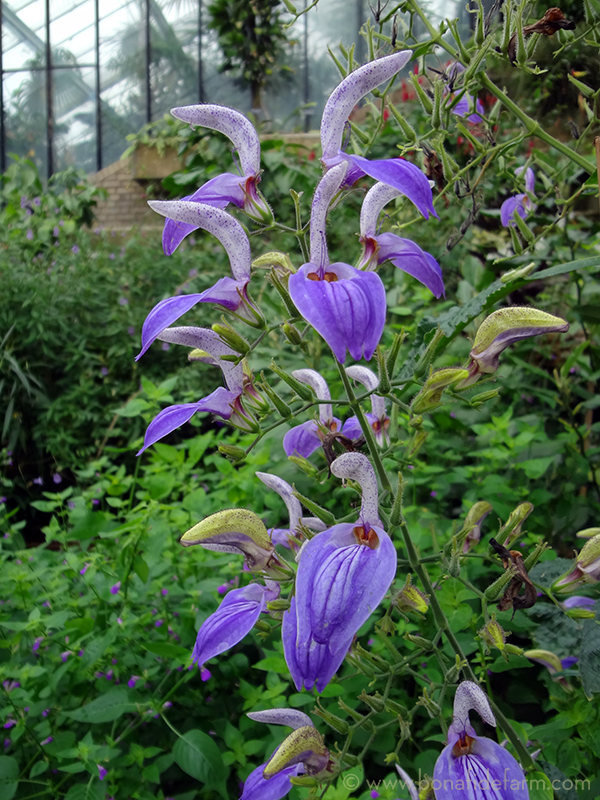
I couldn’t resist, however, this flowering vine growing in one of the glasshouses. I know not what it is, but isn’t it exquisite? If you can i.d. it, tell me in the comments, please!
Up next in part two, walking the grounds of Kew, and getting some wood with the sculptor David Nash.
January 15th, 2014 §
We continue our tour of Bourton House by focusing on a few details. The image below is a good representation of what I just learned from Ursula Buchnan, in The English Garden, is the quintessential English garden: “informal and generous planting within a formal layout.” Such a simple definition but it cracked open a world of understanding for me. You can see the formal elements in the lawn bounded by paving blocks and in the wall at the far end of the path. But the plantings within this structure are riotous—they range and blend together and overspill their bounds onto the lawn.
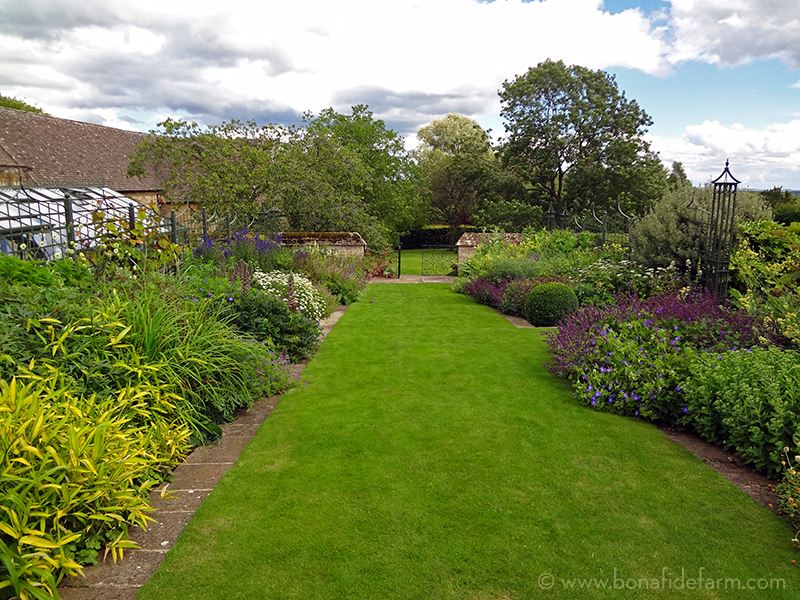
Even though they don’t fit the “English garden” definition as well as the photo above, I loved the areas in the two following photos. The collection of succulents and specimen plants looks like something I do at my own house, when all my tender plants go outside to spend the summer on the porch of the well house. I loved the succulents growing out of the wall, below, which gave the effect of the plants on the ground literally climbing the walls.
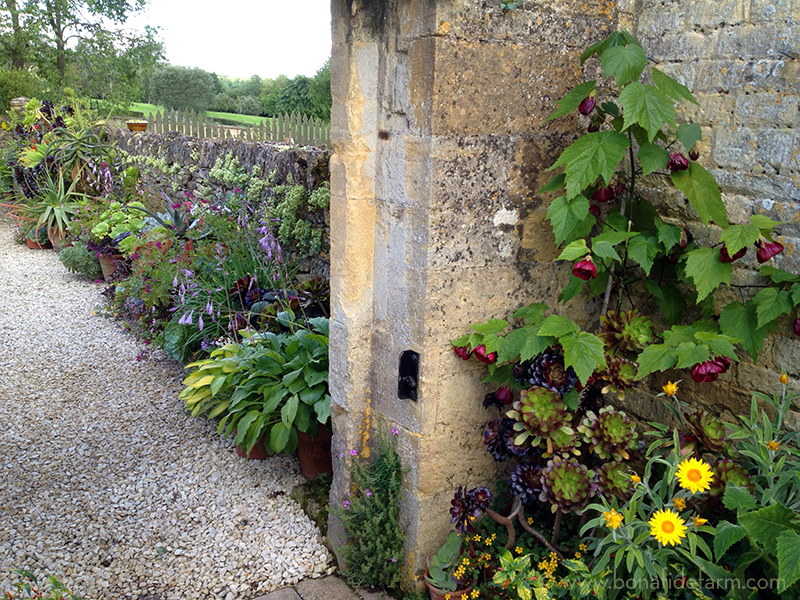
Someone with a great eye for color put this tiny masterpiece together. The shape of the geranium leaves (far right) really plays off the shape of the green and pink succulent in the center and makes for a unexpected and fascinating pairing.
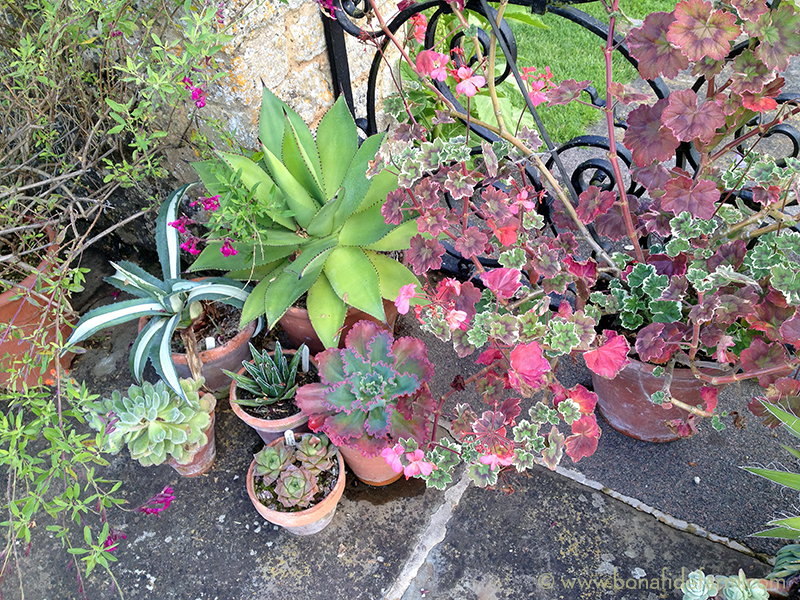
Next up, one of the coolest structures I’ve visited in England, the tithe barn adjoining Bourton House. It has a dedication stone of 1570 with the initials RP for the then owner, Richard Palmer. Back in the Middle Ages it was used to store the one-tenth of the farm’s produce that was tithed to the Church. What I loved about this space, which is now used as a gift shop and event space, was the proportions of the huge interior and the way the yellow Cotswold stone block walls joined to the plaster and beam ceiling. And look at these cross beams! They’re some seriously wonky, wormy, incredibly beautiful old wood.
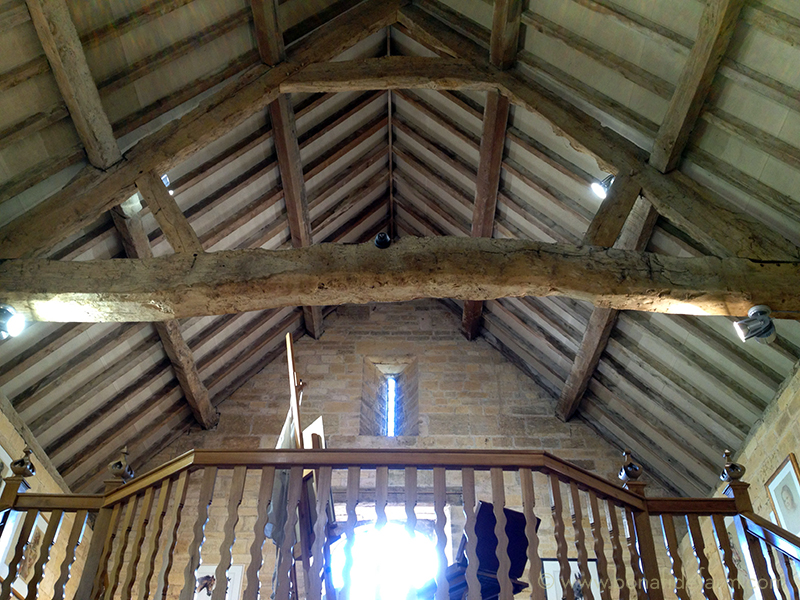
The detail on the balcony railing was also particularly nice, with the wavy balusters. The finials were my favorite—hand-carved and crooked in a wonderful way that made them appear full of personality.
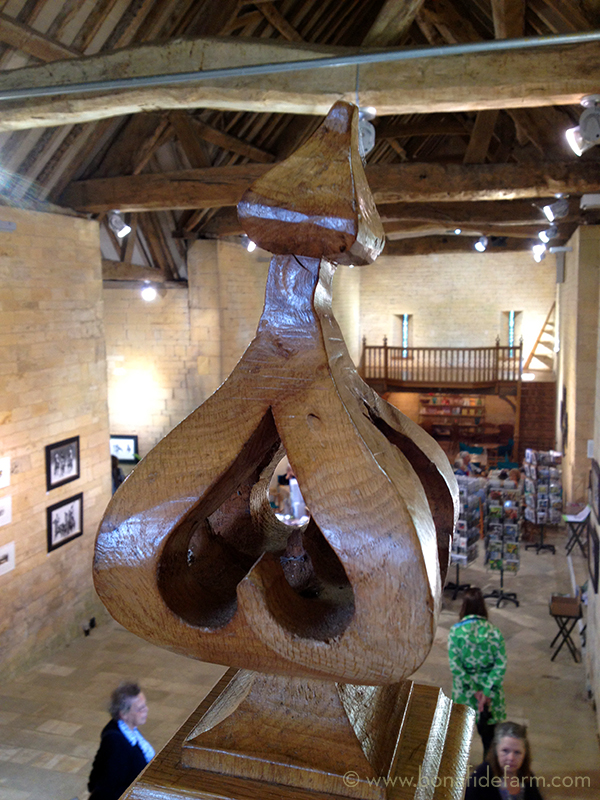
Back outside, I found the only topiary I’ve ever liked:
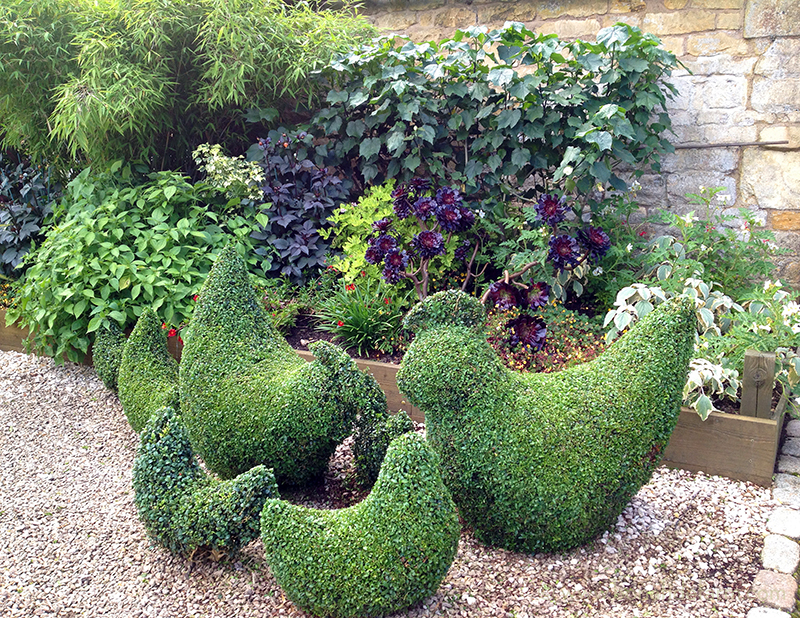
And finally, the mixed shrubbery planted along the exterior of the Bourton House fence is another master class in combining foliage colors.
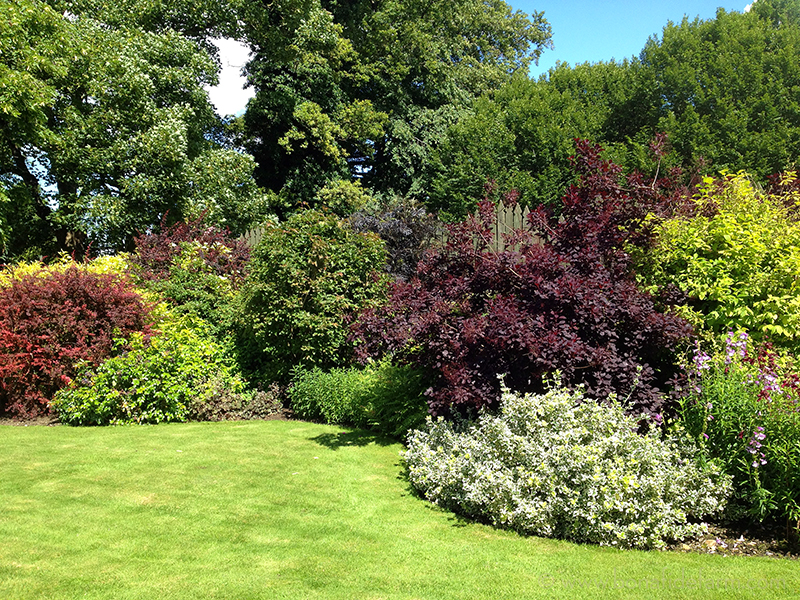
Some day, something like this is what I’ll do in the field between my house and my neighbors, in front of the screening trees that I planted a few years ago. At least this is the vision!
January 13th, 2014 §
It’s cold, dark and raining—you know, typical winter—and I’m seriously missing hours spent in the garden, not to mention the antidepressant effect of playing in the dirt. I really liked writing about the High Line a few weeks ago, and it made me realize that I have untold stories of other equally wonderful gardens. Because of that, and because nobody wants to read a post on how I’ve spent the last two days regrouting my shower, let’s get out of here and find something pretty with a short series on some of my favorite gardens that I’ve visited in the past few years.
First we’ll go to England and visit Bourton House, right in the beautiful Cotswold countryside near Morteon-in-Marsh. I stayed in this area for a couple of weeks in July, 2012, and took these photos then.
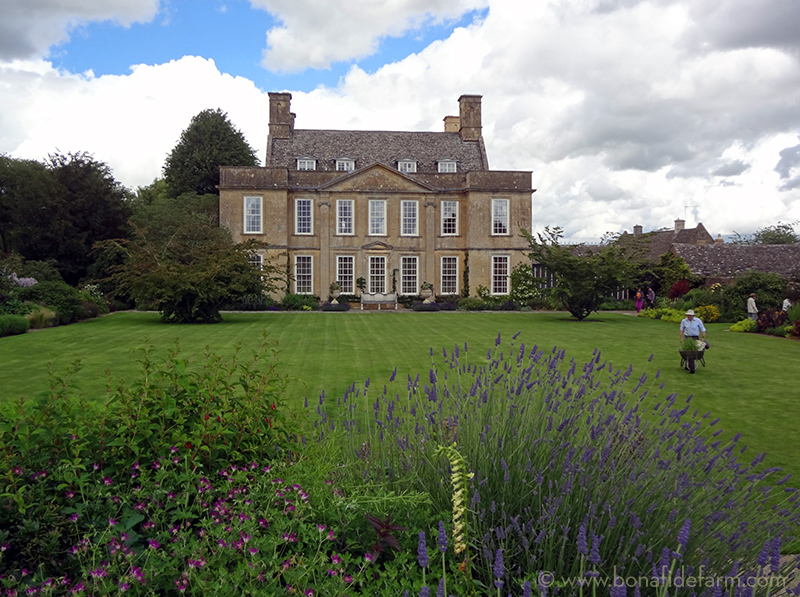
A bit of history from the Bourton House Web site:
Built on monastic lands, Bourton House and its Brewhouse, Stables and Coach House have created a courtyard since the late 16th century.
The house itself was rebuilt as a foursquare Jacobean house by the eminent lawyer, Sir Nicholas Overbury in 1598. At the beginning of the 18th century, the then unfashionable house was once again rebuilt on the earlier footprint by Alexander Popham, the grandson of a Cromwellian general. The house was taken down to its lower ground floor but the whimsical towers retained, the slits replaced by generous Georgian sash windows. The architect remains unknown. This setting has remained unchanged for three hundred years.
The lands originally belonging to the manor were sold in 1851 by Sir James Buller East MP, to the neighbouring Sezincote estate. Today Bourton House is surrounded by its immediate three-acre garden and a seven acre walled pasture, now given over to specimen trees and sculpture.
In 1953 the house and land were sold at auction and there followed a quick succession of owners, six to be exact, until 1983 when the house was acquired by Richard and Monique Paice.

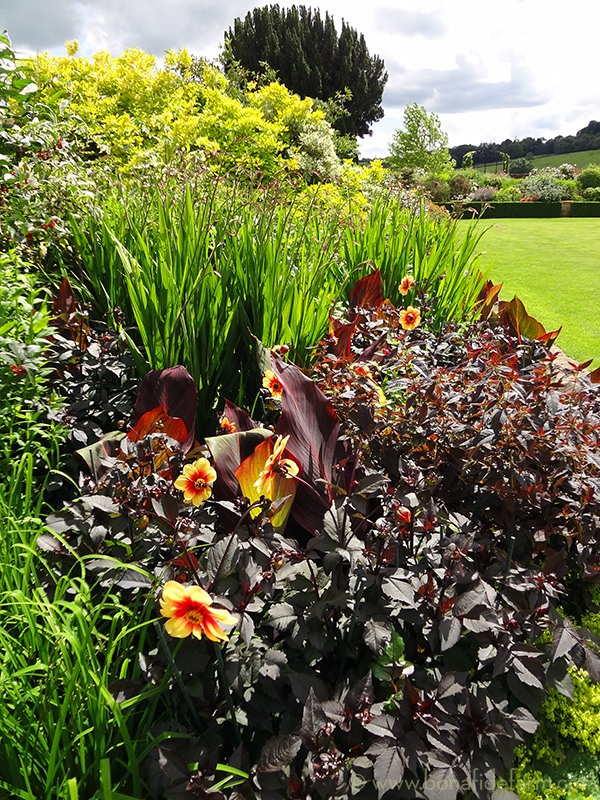
The ornamental garden with its 18th century raised walk overlooking the rolling Cotswold hills; the original kitchen garden and orchard have been transformed in the past twenty five years. This achievement was recognised when Bourton House Garden received the prestigious HHA/Christie’s GARDEN OF THE YEAR (2006) award.
In 2010, the house was sold. The new owners have decided to keep the Garden open to the public with the active help of Head Gardener Paul Nicholls and Assistant Gardener Jacky Rae. Paul and Jacky have been responsible over many years for turning vision into reality and creating the wonderful garden seen today.
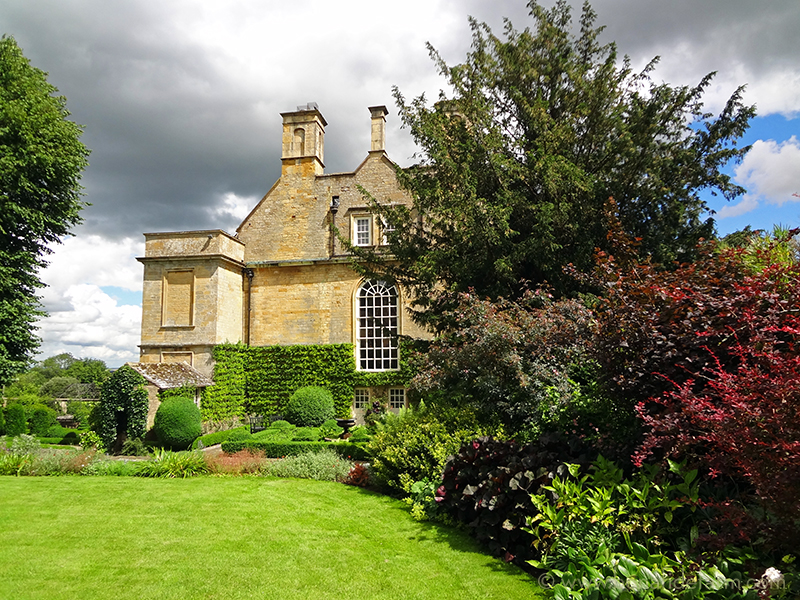
I was really impressed by the use of contrast in the Bourton House garden. As you can see in the two photos above, plants with dark foliage (dahlia and canna up above, and barberry and some other now-unidentifiable things below) are used to break up the swaths of pure green plants and grass. The dark plants create the effect of shadow even in full-sun exposures, and increase the visual depth of the borders.
The estate is surrounded by pastures filled with sheep and cows. It was lovely to hear their soft grazing noises while walking the grounds, and they’re very pretty lawn ornaments! Although I know firsthand that the day-to-day caretaking of livestock can often be the very opposite of bucolic, it was nice to dream a bit and aesthetically appreciate these animals without having to worry about their care.
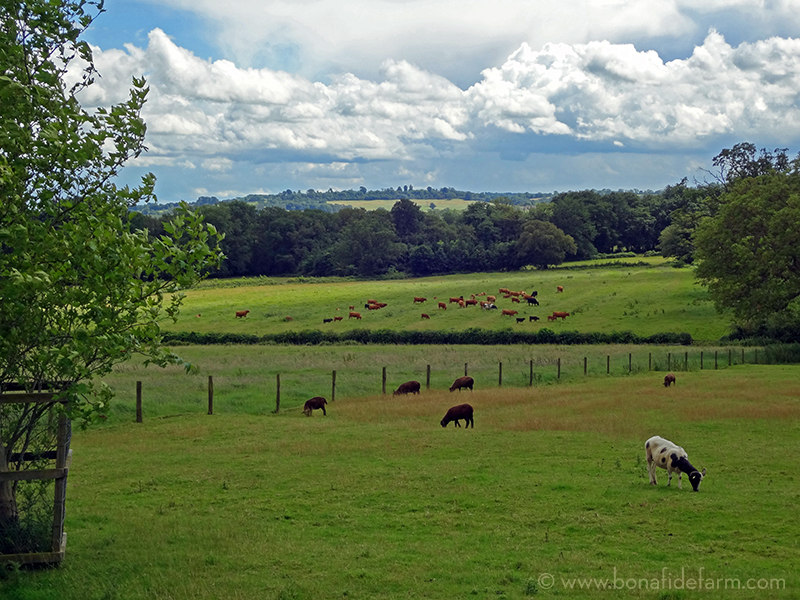
I was impressed by how dynamic the clouds, sky and weather were in England during my visit. You can see in this series of photos, taken in just a couple hours, that the sun moved in and out from behind the clouds. Rain came and went as showers passed by. This made photographing fun and challenging, and the skies were never boring. It also made everything green, green, green! Just looking at these photos is already helping to alleviate my winter doldrums!
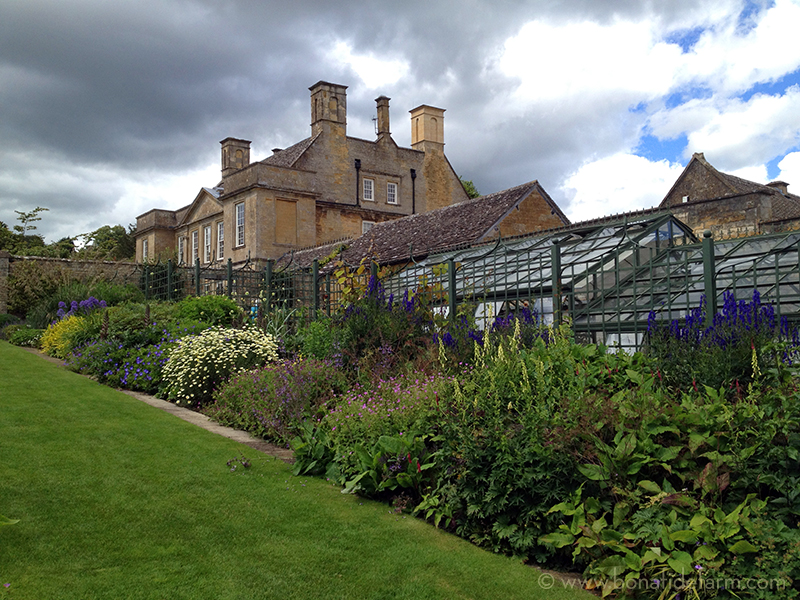
The beautiful glass house wasn’t full as it was high summer in England when I visited, but I can imagine how wonderful that space would be when used to start seedlings and extend the season into fall. Cold frames, below, are built up against the foundation of the glass house and are open to the sun. I love how the more modern glass house is incorporated into the ancient compound without it feeling intrusive or out of place. It’s a good lesson in proper scale and the wonderfully camouflaging properties of dark green paint.
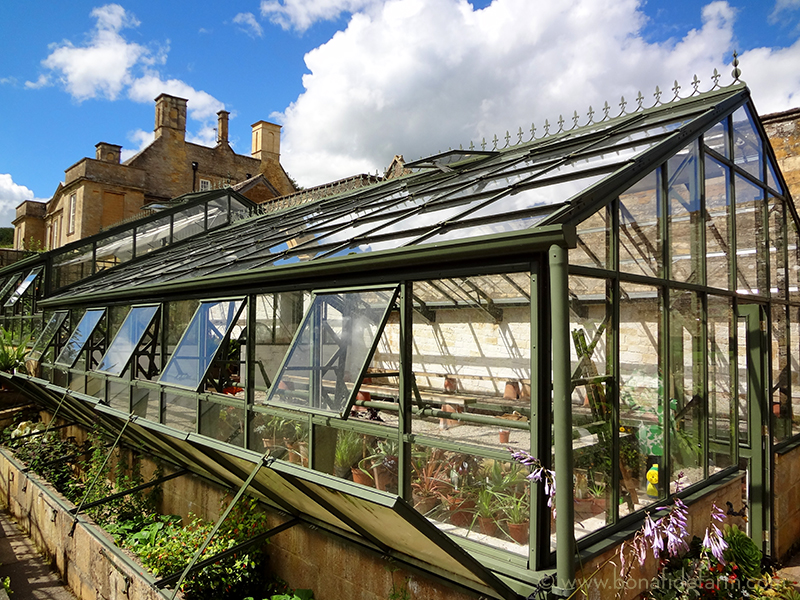
Up next: We examine the Bourton House garden in closer detail, and step inside a gorgeous 16th century tithe barn.




















































